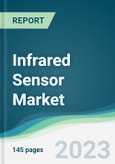The infrared sensor market is estimated to grow at a CAGR of 11.51% during the forecast period.
Infrared sensors detect and measure infrared radiation emitted by objects in their field of view. They work by detecting changes in the temperature or radiation intensity of the infrared energy emitted by objects and then convert this information into an electrical signal that can be interpreted by other devices or systems. The two main types of infrared sensors are passive and active, which can be used in various applications, including optical power meters, radiation thermometers, motion detectors, night vision devices, and proximity sensors, as infrared sensors can detect changes in the infrared radiation emitted by objects. The growing demand for automation and control systems, the need for non-contact temperature measurement, and the increasing adoption of night vision devices drive the demand for infrared sensors, propelling their market growth.The surge in automotive and electronic device production is augmenting the demand for infrared sensors.
A proximity sensor is an electronic device that is used to detect the presence of nearby objects without physical contact. Infrared sensors are particularly useful in proximity sensors because they can detect the infrared radiation emitted by objects and use this information to determine their proximity. The demand for proximity sensors has been increasing in the automotive and consumer electronics sectors. In the automotive industry, proximity sensors are used for parking assistance, collision avoidance, and other safety features. In contrast, they are particularly useful for touchless control, gesture recognition, and other features that improve the user experience in smartphones, tablets, and other consumer electronics devices. The growing production of automotive and consumer electronic devices will boost the demand for infrared sensors. According to the International Organization of Motor Vehicle Manufacturers (OICA), the global production of passenger vehicles increased to 61.59 million in 2022 from 57.05 million in 2021. According to India Brand Equity Foundation (IBEF), smartphone shipments from India crossed 168 million units in CY 2021, and in 2022, smartphone shipments from India were expected to reach ~190 million. This demonstrates that infrared sensors hold a great demand in the future.The growing adoption of night vision devices is boosting the infrared sensor market growth.
Night vision devices like night vision goggles, binoculars, thermal imaging cameras, and others use infrared technology to detect and amplify the faint light available at night, allowing users to see in the dark. Infrared sensors are particularly useful in night vision devices because they can detect infrared radiation even in total darkness. Night vision devices are used in military and law enforcement applications, hunting, wildlife observation, and navigation. Growing demand for night vision devices in such applications is boosting the demand for infrared sensors. In 2022, a global defense and homeland security solutions provider of India was awarded the contract to design & develop night vision goggles for Light Utility Helicopters (LUH) by state-owned Hindustan Aeronautics (HAL) where pilots flying (LUH) in different terrains and day/night will get to wear indigenously manufactured Aviation Night Vision Goggles (ANVG).The Asia Pacific is expected to hold a significant market share throughout the forecast period.
The Asia Pacific region will account for a major market share due rapidly growing consumer electronics market in countries like China, Japan, South Korea, and India, coupled with the growing automotive industry, and increasing usage of night vision devices. In February 2022, to boost India's domestic vehicle production and draw in new investment, 20 automakers were selected to receive production-linked incentives (PLI), including Tata Motors Ltd, Suzuki Motor Gujarat, Mahindra & Mahindra, Hyundai, and Kia India Pvt. Ltd. The 20 automakers have suggested investment of about Rs. 45,000 crores ($5.95 billion) overall. In 2021, the Chinese government announced Export Tax Rebate Adjustment to adjust the export tax rebate rates for certain products, including consumer electronics. The adjustment aimed to support the export of high-value-added products and boost the competitiveness of Chinese companies in the global market. Such developments will boost the demand for infrared sensors used in automobiles, and consumer electronics, thereby boosting the regional market growth.Market Developments:
- April 2023: NEC Corporation, through its proprietary extraction technology, developed the world’s first highly sensitive uncooled infrared image sensors, which use high-purity semiconductor nanotubes for infrared detection.
- January 2023: European consortium launched €19M infrared sensor project to enable Europe to gain technological sovereignty in producing high-performance infrared sensors.
- March 2021: Mitsubishi Electric Corporation launched the Mitsubishi Electric Diode InfraRed (MelDIR) sensor with a new thermal sensor featuring a wide field of view (FoV) and high 80x60 pixel resolution for applications including security, heating, ventilation, air conditioning (HVAC), people counting, smart buildings and thermal scanners.
Market Segmentation:
By Type
- Active
- Passive
By Application
- Motion Detectors
- Proximity Sensors
- Optical Power Meters
- Radiation Thermometers
- Night Vision Devices
- Others
By Geography
- North America
- USA
- Canada
- Mexico
- South America
- Brazil
- Argentina
- Others
- Europe
- UK
- Germany
- France
- Spain
- Others
- Middle East and Africa
- Saudi Arabia
- UAE
- Israel
- Others
- Asia Pacific
- China
- Japan
- India
- South Korea
- Others
Table of Contents
1. INTRODUCTION
2. RESEARCH METHODOLOGY
3. EXECUTIVE SUMMARY
4. MARKET DYNAMICS
5. INFRARED SENSOR MARKET BY TYPE
6. INFRARED SENSOR MARKET BY APPLICATION
7. INFRARED SENSOR MARKET BY GEOGRAPHY
8. COMPETITIVE ENVIRONMENT AND ANALYSIS
9. COMPANY PROFILES
Companies Mentioned
- ABB
- Amphenol
- Excelitas Technologies Corp
- Honeywell International Inc.
- Murata Manufacturing Co. Ltd
- Omron Corporation
- Panasonic
- Raytheon Technologies Corporation
- STM Electronics
- TE Connectivity
Methodology

LOADING...







